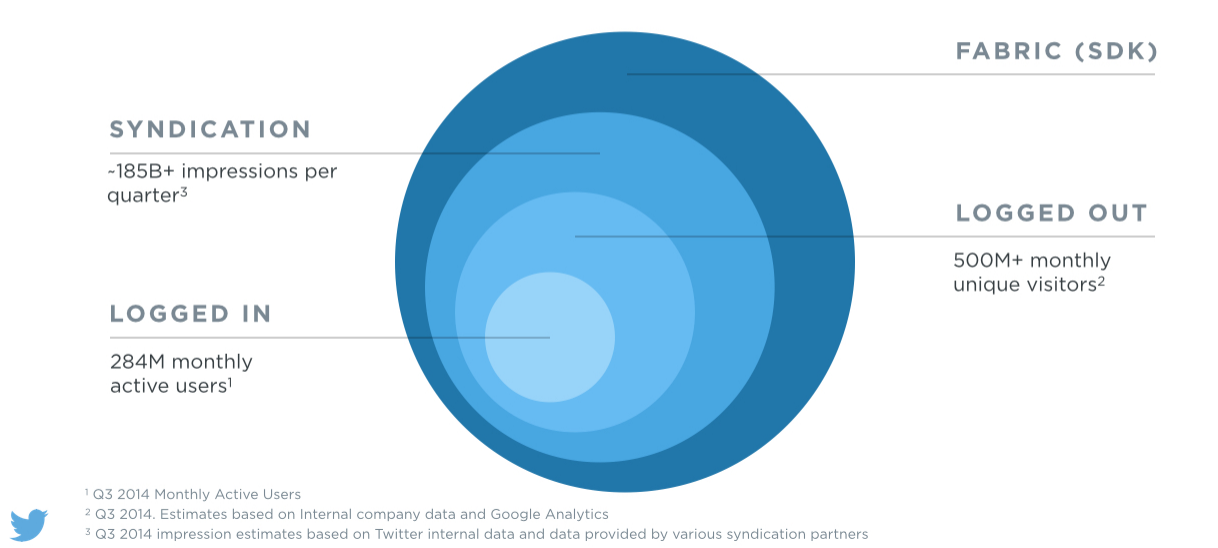What's Next for Twitter Advertisers: Video, SEO, & Expanded Audience
In the coming year, look for a focus on native video, SEO, and syndication from the social media platform.
In the coming year, look for a focus on native video, SEO, and syndication from the social media platform.
When it comes to the inner workings of its advertising network, Twitter tends to hold its cards close to its chest. However, a recent presentation everyone’s favorite microblogging service made to analysts uncovered some previously unknown insights into how Twitter ads really work – and what it has planned for the future.
Twitter’s entire focus is changing and it just might make it a real contender in the social advertising arena and beyond.
Browsing through its presentation to analysts revealed a few interesting pieces of information:
On November 12, Twitter held its first analysts day, with several Twitter execs laying out their ambitious goals to investors. In his portion of the presentation, vice president of product Kevin Weil talked about features coming to Twitter over the coming year.
One of particular interest to marketers is native video, which will launch in the first half of 2015. Over the past year, Twitter has integrated Vines, GIFs, and embedded video into the user timeline. In a blog post following the analyst presentation, Weil announced, “…aside from just watching video more easily on Twitter, you should be able to record, edit, and share your own videos natively on Twitter, too. Alongside short looping Vine videos, we think you’ll have fun sharing what’s happening in your world through native video.”

Image credit: Twitter
Twitter has been testing native video with advertisers since March of this year and in August, began beta testing Promoted Video. Sold on a cost-per-view basis, advertisers are charged only when users begin playing a video. Tweets with native video get better engagement than those with video links, according to Twitter.
Watch for Twitter to roll out native video to all users and to expand Promoted Videos to more advertisers in the coming months.
There are 248 million monthly active users on Twitter, but the network wants you to think in terms of the overall audience including “logged out users,” bringing the total audience of logged in and logged out monthly users to 500 million.
What are logged out Twitter users, you ask? These are the people who click on a link somewhere to land on a Twitter page, typically one belonging to a celebrity or popular brand. Some 75 million of these users come from search. Moving even beyond that, though, the Twitter audience actually consists of four concentric circles of users, they said.
Syndicated content viewers are those who view embedded tweets in content and sites around the Web, accounting for an additional 185 billion impressions per quarter. In his part of the presentation, Twitter chief financial officer (CFO) Anthony Noto hinted at a publisher network that would monetize those tweets appearing around the Web.

This is where Twitter plans to stake its claim to the “largest daily audience” on the Web: logged in users, logged out users, viewers of syndicated content, and finally, the Fabric audience. Fabric is the mobile app platform Twitter introduced in October, designed to tap into the mobile ad market (Facebook, Google, and Yahoo all have competing products already).
The expanded audience mantra is key to Twitter’s ambitious growth goals and points to new areas of focus marketers need to have on the radar.
What does all of this mean for marketers?
It’s true! Noto outlined three major objectives for Twitter in the near term and expanded on each with specific goals, one of which is to “expand content reach via distribution partnerships, SEO, & syndication.”

Under “reduce barriers to consumption,” Twitter also indicated they plan to better organize content, deliver consumption-first experiences for logged out users, and improve topic-based search.
In “strengthening their core,” Twitter plans to tailor products to local markets and more effectively use geo-based data to target location-based content and services.
What does all of this mean to marketers?

It would be too easy to write off Twitter advertising if you haven’t experienced any great results there to date. With 248 million monthly active users, it’s dwarfed by Facebook’s reach and has an audience only slightly larger than Instagram. But Twitter’s plans to expand beyond its active audience and continue to address each stage of the funnel with innovative ad products, might tip the scales back in its favor.
Twitter seems to be heading in a new direction and that could be very good news for marketers. Its entire vision has changed from that of an insular, niche network to one of an ambitious, wannabe global advertising giant. It’s going to require Twitter moving beyond its borders and as much as that makes investors nervous, it’s also going to bring interesting new products for advertisers to test out as they come available.
Noto expects Twitter to reach 2 billion monthly active users by 2020, with $14 billion in revenue by 2024. The monetization of logged out users and syndicated content is key to their coming anywhere close to accomplishing these lofty goals; marketers need to prepare to capitalize on this expanded reach as it opens up.
Are you ready?
This article was originally published on ClickZ.